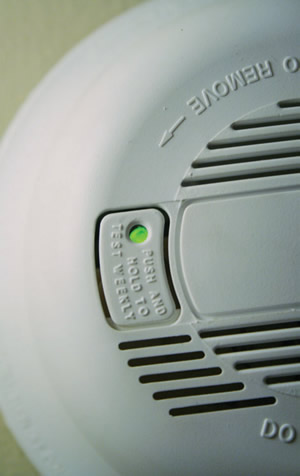A Mix of Technology and Education
- By Bernard Cattrell
- 10/01/14

PHOTO COURTESY OF MICHAEL HICKS
Colleges and universities have made great strides in the past 20 years in improving the protection of students by installing or upgrading fire alarm systems and/or installing sprinkler systems. However, similar success has not been achieved in the off-campus properties that many students use while in college.
The Center for Campus Fire Safety defines off-campus housing as being within three miles of a campus. Seventy-three fires have occurred in off-campus housing claiming 104 victims since January 2000. Those numbers are 84 percent of the reported campus fires and 85 percent of the fire deaths. Therefore, making efforts to reduce those numbers will make a huge difference in the number of campus fires and fire deaths.
How is that to be accomplished? First, educate students using the materials available from the International Code Council, National Fire Protection Association, U.S. Fire Administration and/or the Center for Campus Fire Safety. The NFPA in particular has student-focused flyers available on their website.
Second, install electric interconnected smoke detector equipment that shuts off the electricity supply when smoke is detected. Cooking equipment accounts for 84 percent of campus fires and 29 percent of the student injuries.
Finally, it’s important to educate the owners of off-campus rental housing about their need to provide state-of-the-art, monitored fire-detection systems to reduce their liability and to ensure a properly functioning system to alert occupants. Commercial wireless fire alarm systems are now available and are great for existing single- and multi-family structures in the off-campus rental housing stock. The only portion that is hardwired are the horn/strobe devices. Also, every device sends a notification to the monitoring center when it is removed from its base or when the battery power is low, thus preventing removal, and also notifying management to replace batteries.
When off-campus housing structures have competent, full-service systems installed to protect the students, the next area to address will be actions taken by students, both on- and off-campus. For one of my sons, it was the decorations the students in his residence hall placed on his floor for their open house to mimic “The Magic School Bus,” with black plastic trash bags taped to the ceilings and walls to create a space appearance. Also, cardboard-box tunnels were placed in the hallways to the students’ rooms. They removed multiple fire doors and left a pallet of cardboard at the top of the stairs, impeding egress to the top mechanical floor. Thankfully they triggered the fire alarm system with dust when they began to dismantle the decorations and local fire officials would not leave nor allow the students to reoccupy the structure until their decorations were completely removed. Lesson learned, without incident. This time.
While you never know when accidents will happen, the combination of technology and education can save lives.
This article originally appeared in the issue of .
About the Author
Bernard Cattrell is a 42-year member of the fire service, with the last 14 as a fire inspector with Washington Township Fire Department in Dublin, OH. He and his wife, Charissa, have three college-graduate sons who occupied both on- and off-campus housing.